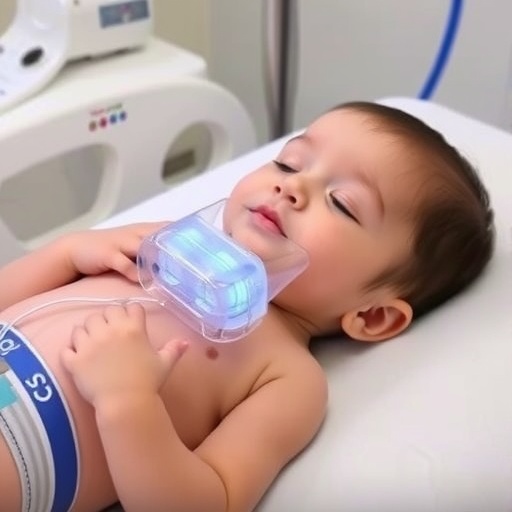In a groundbreaking development in pediatric healthcare, researchers have unveiled a non-invasive skin biomechanical device that holds promise for the swift assessment of dehydration in children. Dehydration, a condition frequently encountered in young patients, can lead to severe health complications if not diagnosed and treated promptly. This innovative device seeks to address the critical gap in rapid dehydration assessment methods, which are often cumbersome and time-consuming. The case-control study executed by Büyükdereli Atadağ et al. aims to establish a new gold standard in evaluating pediatric dehydration through a simple and efficient approach.
Dehydration in children can arise due to various factors, including illness, inadequate fluid intake, or excessive fluid loss due to sweating or diarrhea. Left unchecked, dehydration can cause serious complications, affecting vital organ functions and potentially leading to hospitalization. Traditional methods to assess dehydration often rely on clinical evaluation, which can be subjective and may vary significantly based on a clinician’s experience. By introducing a biomechanical device, researchers aim to provide a consistent and accurate means of measuring hydration levels in children.
The device employs cutting-edge technology, analyzing skin biomechanical properties to determine hydration status. The premise is simple yet profound: skin turgor, elasticity, and hydration levels can yield insights into a child’s overall hydration status. Unlike traditional methods such as blood tests or visual assessments, this device offers a real-time, patient-friendly alternative that can be particularly valuable in emergency settings. Its non-invasive nature means that it can be used more frequently without the discomfort associated with blood draws or invasive procedures.
In this study, the device was tested on a sample of pediatric patients diagnosed with varying degrees of dehydration. The study’s design ensured a rigorous approach to data collection, comparing the device’s readings with established clinical evaluations. The results indicated that the device displays a high level of accuracy and reliability, thereby reinforcing its potential utility in clinical practice. With further validation, this technology could revolutionize how healthcare providers approach dehydration assessments in pediatric populations.
The implications of this technology extend beyond mere convenience. By enabling rapid assessment, clinicians can initiate treatment sooner, potentially avoiding the deterioration of a child’s condition. In rural or resource-limited settings where access to advanced medical facilities is restricted, this device could serve as a vital tool for primary care providers. Its portability and ease of use mean that healthcare workers can carry it to various locations, providing immediate assessments on-site.
Moreover, the study highlights a pressing need for innovation in pediatric healthcare. As the landscape of healthcare continues to evolve, there is an increasing emphasis on patient-centered approaches that prioritize comfort and minimize distress, particularly in vulnerable populations like children. This device aligns perfectly with that ethos, offering a stress-free way to monitor hydration that respects the sensitivities of young patients.
As children have unique physiological characteristics, especially regarding hydration, the ability to accurately assess their needs is paramount. Measuring hydration levels using advanced technology not only enhances clinical outcomes but also empowers parents and guardians by providing them with immediate and comprehensible results. They can be more engaged in their child’s healthcare process, leading to improved compliance and satisfaction.
The findings of this research are timely, given the increasing prevalence of dehydration-related complications among children, especially in developing countries where healthcare resources may be stretched thin. This device could fill significant gaps in pediatric care, ensuring that healthcare providers have powerful tools at their disposal to combat dehydration effectively and efficiently. As healthcare systems globally strive for better outcomes, technologies like these represent a shift toward more proactive and evidence-based practices.
Future studies will delve deeper into diverse populations to ensure the device’s efficacy across varying demographics. There remains a commitment to rigorously testing its performance against traditional methodologies and refining the technology based on user feedback from medical professionals using the device in real-world scenarios. As the body of evidence grows, the hope is that adoption will occur seamlessly across pediatric healthcare facilities worldwide.
In conclusion, the emergence of the non-invasive skin biomechanical device is a significant step forward in addressing pediatric dehydration. The device’s feasibility demonstrated in this case-control study suggests a pathway toward improved outcomes in children’s health. It signifies an innovation that could potentially establish new protocols in assessing dehydration, underscoring the urgency for advancements in medical technology tailored to children’s needs. As researchers continue to explore applications and refine the technology, the pediatric medical community prepares for a future where dehydration assessments are swift, accurate, and, most importantly, child-friendly.
Subject of Research: Non-invasive skin biomechanical device for pediatric dehydration assessment
Article Title: Feasibility of a non-invasive skin biomechanical device for rapid assessment of pediatric dehydration: a case–control study
Article References:
Büyükdereli Atadağ, Y., Saygılı, T., Temizkan, Z. et al. Feasibility of a non-invasive skin biomechanical device for rapid assessment of pediatric dehydration: a case–control study.
BMC Pediatr 25, 949 (2025). https://doi.org/10.1186/s12887-025-06333-w
Image Credits: AI Generated
DOI: https://doi.org/10.1186/s12887-025-06333-w
Keywords: Pediatric dehydration, non-invasive assessment, skin biomechanical device, rapid assessment, healthcare innovation.




